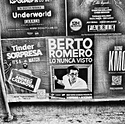dwross2
Member
- Joined
- Jan 3, 2007
- Messages
- 160
- Format
- Large Format
I finally, really, get it. I haven't had so much fun with a camera for years. Did you know that a camera can be handheld? Amazing. And that if you're around other people they don't all stop and ask what you're doing? (Actually, I might have to take out a view camera a couple of times a year just to strike up conversations with strangers. I think I could miss that part ) But I still haven't decided if it's a blessing or a curse that I have about 10 times the images to evaluate than I have ever gotten on the best of film shoots. At least it's a happy conundrum.
) But I still haven't decided if it's a blessing or a curse that I have about 10 times the images to evaluate than I have ever gotten on the best of film shoots. At least it's a happy conundrum.
Words of wisdom and I wholeheartedly agree. I don't have a firm idea in my head about what I want my gum-overs to look like. If I close my eyes, I see old varnish on oil or soot-softened frescos. For me, trying to match the colors as closely as possible, as I'm learning, gives me a benchmark to fully understand the materials and processes. Who knows where it can go from there? I do know that I want to keep the spirit of the fun and adventure of art that I feel right now. I think I'll call my gum-over prints the "Gummy Bare Gallery". Ok, ok, maybe just a bit goofy? It must be sunstroke.
Best to all,
d
 ) But I still haven't decided if it's a blessing or a curse that I have about 10 times the images to evaluate than I have ever gotten on the best of film shoots. At least it's a happy conundrum.
) But I still haven't decided if it's a blessing or a curse that I have about 10 times the images to evaluate than I have ever gotten on the best of film shoots. At least it's a happy conundrum. Denise, I'm wondering how important it is to you to achieve a precisely accurate color reproduction.
Words of wisdom and I wholeheartedly agree. I don't have a firm idea in my head about what I want my gum-overs to look like. If I close my eyes, I see old varnish on oil or soot-softened frescos. For me, trying to match the colors as closely as possible, as I'm learning, gives me a benchmark to fully understand the materials and processes. Who knows where it can go from there? I do know that I want to keep the spirit of the fun and adventure of art that I feel right now. I think I'll call my gum-over prints the "Gummy Bare Gallery". Ok, ok, maybe just a bit goofy? It must be sunstroke.
Best to all,
d





